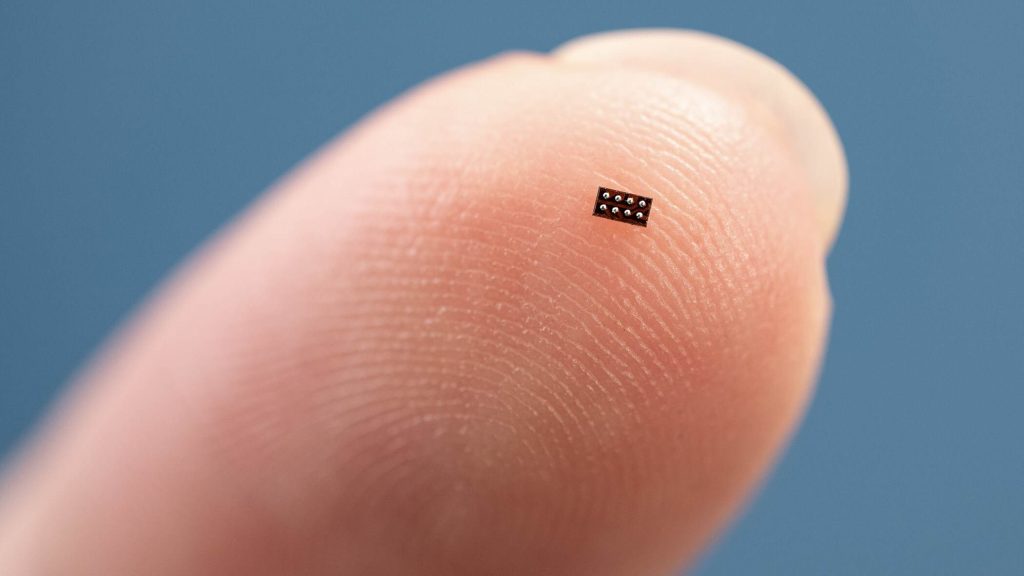Imagine a health tracker embedded in a ring, a smart necklace that monitors your wellness in real time, or a medical sensor so small it’s barely detectable – all powered by ultra-efficient components that maximize battery life and minimize size.
This level of innovation is rapidly becoming reality, thanks to Texas Instruments’ latest breakthrough in embedded technology. TI has unveiled the world’s smallest microcontroller (MCU), a game-changing advancement that enables entirely new generations of wearable and smart devices across lifestyle, healthcare, wellness, and fashion tech. With its compact footprint and optimized performance, this MCU opens doors to more creative, functional, and discreet designs than ever before.
For the full details on this groundbreaking innovation, you can read the official announcement on the TI Newsroom.
Technical Overview: Mighty Performance in a Tiny Package
The MSPM0C1104, a new addition to TI’s comprehensive MSPM0 MCU portfolio, redefines the industry standard for compact computing. Measuring a mere 1.38mm² – roughly the size of a black pepper flake – this microcontroller integrates advanced capabilities into an unprecedentedly small footprint. Its wafer chip-scale package (WCSP) design is specifically engineered to maximize board space efficiency without compromising performance, addressing a critical need in space-constrained applications.
This MCU features 16KB of memory, a 12-bit analog-to-digital converter with three channels, six general-purpose input/output pins, and compatibility with standard communication interfaces including UART, SPI, and I2C. The strategic integration of high-speed analog components alongside digital processing within such a compact form factor provides engineers with unparalleled flexibility, enabling them to maintain robust computing performance while significantly reducing product size and complexity. This device exemplifies TI’s commitment to delivering optimized sensing and control solutions that accelerate development cycles and reduce overall system costs.

Why This Matters: Enabling the Next Generation of Wearables
The MSPM0C1104’s unprecedented miniaturization addresses a critical challenge in modern electronics: the growing demand for more functionality in increasingly smaller form factors. This breakthrough has particular significance for several key applications:
Medical Wearables: The tiny footprint enables development of nearly invisible health monitoring devices that can be seamlessly integrated into clothing, skin patches, or even surgical tools. Imagine continuous glucose monitors that are virtually unnoticeable or smart bandages that monitor healing progress in real-time.
Lifestyle and Consumer Wearables: The ultra-compact size fundamentally expands the possibilities for increasingly sophisticated and creative form factors. The MSPM0C1104 enables smart jewelry that monitors wellness metrics, intelligent clothing accessories that track posture and movement, or lifestyle devices seamlessly integrated into eyewear, rings, and fashion accessories. This miniaturization breakthrough allows designers to prioritize aesthetics and user experience while embedding powerful computing capabilities into products that users want to wear daily.
Industrial and Automotive Applications: The microcontroller opens doors for embedded intelligence in the smallest sensors and actuators, enabling more granular monitoring and control in industrial systems and automotive components.
Next-Generation User Interfaces: The combination of ultra-small sensors and this tiny MCU could enable entirely new interaction paradigms, from gesture-sensing contact lenses to invisible smart surfaces.
As consumers increasingly expect more features packed into smaller devices, components like the MSPM0C1104 become essential enablers of innovation, particularly in the rapidly growing medical and consumer wearables markets.
Application-Level Software Features for Wearables, Medical, and IoT Devices
To truly harness the potential of the MSPM0C1104 in real-world products, mobile and desktop apps must be intelligently designed to interact with and enhance these embedded systems. Below are key software features and UI-level capabilities that can be implemented at the application layer, with a focus on wearable device development, healthcare sensor integration, and IoT/industrial edge computing:
Wearables & Lifestyle Tech Apps
- Real-time sensor dashboards: Live visualization of motion, temperature, or voltage using high-speed ADC data.
- Power optimization tools: Monitor and configure low-power modes (RUN/STOP/STANDBY) to maximize battery life.
- Stylus and input diagnostics: Track sensor input like pressure, tilt, or gesture for smart accessories.
- Firmware update management: Enable OTA or USB-based firmware updates for long-term device reliability.
- Beep/haptic feedback configuration: Set up interactive audio/tactile feedback through UI sliders.
Medical Device Apps
- Continuous health monitoring: Display metrics like temperature, heart rate, and signal trends from wearables or patches.
- Threshold alerting and logging: Annotate and store medically relevant events with secure local or cloud backup.
- Sensor calibration interfaces: Adjust internal voltage references and ADC gain for accurate readings.
- Compliance logging and export: Generate exportable reports in PDF or CSV for clinical or diagnostic use.
Industrial/IoT Applications
- Serial protocol configuration panels: GUI-based control over I2C, SPI, and UART communications.
- Device health and uptime trackers: Analyze operational data like wake counts, power cycles, and watchdog resets.
- Multi-device firmware deployment: Manage and update fleets of embedded sensors in manufacturing or automotive environments.
- Offline sync tools: Store operational data locally on device and sync to mobile/desktop app when in range.
By designing these kinds of apps, developers not only extend the functionality of hardware products but also create an ecosystem where firmware, UI/UX, data handling, and connectivity work seamlessly together – a vital differentiator in the competitive market for connected health, lifestyle, and industrial products.
Developex Expertise in Electronics Software Development
Even groundbreaking hardware can only realize its full potential through exceptional electronics software development and system integration. At Developex, we specialize in crafting advanced firmware and application software for embedded systems and electronic devices, including but not limited to wearables, Smart Home & IoT, wellbeing and health products, as well as other software development for the electronics industry.
We understand how challenging it can be to navigate the complexities of embedded development – from hardware-software integration to ensuring reliability, scalability, and user experience in constrained environments. Our proven expertise in custom embedded software, companion mobile apps, and real-time device communication helps global brands build connected products that delight users and stand out on the market.
Learn more about how we approach these challenges and manage successful projects in our guide: How to Effectively Manage Software Development for Consumer Electronics.
If you need expert guidance on electronics software development or insights into managing complex projects, simply fill out form below. We’re here to support your development goals.






